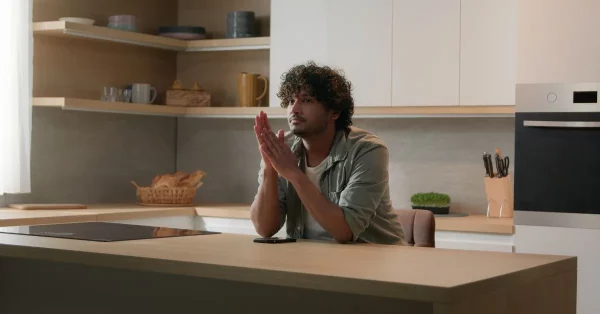Following a stroke, doctors often recommend pursuing rehabilitation, including physical, occupational, and speech therapies. Depending on the areas of the brain affected by stroke, communication, cognition, and swallowing skills may be impacted. Participating in speech therapy after stroke can allow survivors to regain these skills by rewiring the brain to allow healthy areas to take over these functions.
Speech therapy after stroke can be beneficial to a wide variety of survivors, including those with conditions such as aphasia, apraxia of speech, dysarthria and dysphagia. Through individualized exercises, adaptive techniques, and education, speech therapy after stroke is an excellent way to improve functions related to communication, cognition, and swallowing.
Please use the links below to jump directly to any section of this article.
- How does stroke affect speech?
- Who can benefit from speech therapy after stroke?
- How does speech therapy work?
- What to expect during speech therapy
How Does Stroke Affect Speech?
A stroke occurs when the blood flow within the brain becomes compromised, depriving the brain of oxygen and essential nutrients. This may occur when there is a blockage within an artery (ischemic stroke) or when a blood vessel ruptures (hemorrhagic stroke). Depending on the area(s) of the brain affected by stroke, a variety of physical, cognitive, emotional, or behavioral functions may be affected.
Among these affected functions are speech, language, and communication skills. While many areas of the brain are involved in these functions, the main areas involved in communication include:
- Broca’s area: responsible for expressive language skills
- Wernicke’s area: involved in receptive language and comprehension
- Primary motor cortex: initiates voluntary movements throughout the body, including movement of the mouth and tongue
When a stroke causes damage to these areas, especially Broca’s or Wernicke’s areas, speech is likely to be affected. Thus, survivors with damage in these areas of the brain are likely to benefit from speech therapy after stroke.
Who Can Benefit from Speech Therapy After Stroke?
Speech therapists, also referred to as speech-language pathologists, are able to treat a variety of conditions. Aside from being the experts in speech and language skills, speech therapists are also able address challenges such as difficulties with cognition, social communication skills, and/or eating and swallowing.
This is because all of these areas are closely intertwined. Communication involves physically producing speech through coordinated oral motor movements, cognitively comprehending and formulating a response, and behaviorally following the unwritten rules of socialization. Since coordinated oral motor movements are also involved in eating and swallowing, speech therapists are able to address these skills as well.
With this in mind, some of the primary conditions treated during speech therapy after stroke include:
- Aphasia: difficulty producing and/or understanding language
- Apraxia of speech: difficulty with coordinating movements required for speech
- Dysarthria: oral motor weakness resulting in speech that is difficult to understand
- Dysphagia: difficulty swallowing
Survivors who experience any of these conditions should ask their doctor about a speech therapy referral. Even if a survivor is currently unable to speak or it has been years since their stroke, recovery may still be possible.
How Does Speech Therapy Work?
When the brain sustains damage due to a stroke, the damaged areas are no longer able to effectively carry out their respective functions. However, through a process referred to as neuroplasticity, the brain has the ability to rewire itself to allow undamaged areas of the brain to take over these functions.
Neuroplasticity is activated through consistent, repetitive practice. Practicing affected functions signifies to the brain that there is demand for those functions, promoting adaptive rewiring to occur. The more frequently an affected function is practiced, the stronger the neural connections for that function become.
Speech therapy after stroke is an excellent way to learn some of the most effective exercises and activities to improve affected functions and promote neuroplasticity. However, while practicing speech therapy exercises and activities during sessions is a great start, consistent repetition is essential for neuroplasticity.
Therefore, many speech therapists provide stroke survivors with a home program to continue practicing affected functions even outside of therapy sessions. Some may even recommend downloading an app, such as the CT Speech and Cognitive Therapy App, to motivate individuals to practice speech therapy exercises on a regular basis.
Since the brain experiences a heightened state of neuroplasticity during the first three months following a stroke, pursuing speech therapy during this time period is optimal for recovery. However, since neuroplasticity is constantly occurring, any time, even years after stroke, is a great time to start speech therapy to begin making improvements.
What to Expect During Speech Therapy
Speech therapy after stroke can take place in a variety of settings. Many survivors begin speech therapy while still in the hospital, while others have a speech therapist come directly to their home. Still others participate in speech therapy as a part of their rehabilitation program in a skilled nursing facility, or they may attend an outpatient therapy clinic. Depending on the setting and the survivor’s needs, speech therapy sessions may be daily, or just once or twice per week.
Speech Therapy in the Hospital
Speech therapy in the hospital setting is unique in that survivors are in a very acute period of recovery after stroke. In this setting, speech therapists often play an essential role in ensuring individuals are able to safely chew and swallow their foods. They may assess a survivor’s ability to drink liquids of various consistencies or to chew different textures of food.
This can inform the dietary staff at the hospital, as well as caregivers or family members at home, as to which types of foods and drinks are safe for the survivor to consume. Making sure that survivors are able to effectively chew and swallow the types of foods they are given is vital to prevent further complications after stroke, such as choking or aspiration pneumonia. While ensuring survivors are able to safely eat and drink is the most critical role of speech therapists in the hospital setting, they are also able to assess communication and cognition skills in this setting.
Speech Therapy Evaluation
It is still beneficial to start speech therapy after stroke as soon as possible. During one’s first therapy session, the speech therapist will review the survivor’s medical history and assess their current challenges and abilities in order to develop a customized rehabilitation plan.
Especially when speech or cognition is affected, it may be very beneficial to have a caregiver or family member present during this initial assessment to provide a fuller picture of the survivor’s circumstances. While speech therapists may use standardized assessments to determine which areas to address in future sessions, informal assessments may also be utilized. At the end of this initial evaluation session, speech therapists will often discuss what goals the survivor and their family hope to achieve, and describe what the course of treatment may look like.
Speech Therapy Interventions
There are many treatment strategies and interventions that may be used throughout speech therapy after stroke. Depending on the survivor’s needs, speech therapists may use the following treatments to promote recovery:
- Exercises. Oral-motor and/or cognitive exercises can be used to improve communication and swallowing skills. Oral-motor exercises may include specific, coordinated movements of the mouth, tongue, and face, while cognitive exercises may include naming or memory tasks.
- Therapeutic Activities. Engaging activities may be more motivating to survivors, which can lead to more repetitive practice of skills and increased neuroplasticity. Examples of therapeutic activities include practicing word games such as Boggle or completing tasks involving multistep directions.
- Compensation Techniques. While the ultimate goal of speech therapy after stroke is to recover lost functions, learning to work around current deficits is also important. Compensation techniques, such as speaking more slowly or consuming a modified diet, can help survivors participate in daily activities more safely, easily, and independently.
- Melodic Intonation Therapy. Also referred to as singing therapy, this is a technique that speech therapists may use to help those who struggle with producing speech. Singing activates a different area of the brain than speaking, thus survivors who are unable to speak may still be able to express words while singing.
- Electrical Stimulation. E-stim involves using electrodes on the skin to stimulate the muscles involved in speaking and/or swallowing. For example, VitalStim Therapy can be used with survivors with dysphagia to activate muscles in the neck involved in swallowing.
These are just some of the many interventions that speech therapists may use to promote recovery after stroke. While these techniques are excellent ways to start on the road to recovery, continuing to practice exercises and activities used during speech therapy at home is essential to optimizing neuroplasticity.
The Role of Caregivers and Loved Ones
Caregivers, family members, and other loved ones can play a vital role in promoting recovery after stroke. In addition to encouraging survivors to participate in speech therapy, they can also remind and motivate survivors to continue practicing the skills they’ve gained in therapy at home.
Speech therapists may also be able to educate caregivers and loved ones on strategies to support survivors on a daily basis. This may include education regarding how to best communicate with survivors with speech and language deficits, support those with cognitive challenges, and provide a healthy and safe diet for survivors with dysphagia.
While recovering from stroke may be challenging, support from caregivers and loved ones can help motivate survivors to continue pursuing recovery. Acknowledging small improvements, advocating for appropriate care, and being present during both good times and bad can make a world of difference. Speech therapists are excellent resources for caregivers and loved ones to collaborate with to support survivors and promote recovery.
Understanding Speech Therapy After Stroke
Many survivors may benefit from speech therapy after stroke. While some of the most common conditions addressed include aphasia, apraxia of speech, dysarthria, and dysphasia, speech therapy can be beneficial for any survivor with communication, cognition, or swallowing challenges.
Participating in speech therapy is an excellent way to activate neuroplasticity and promote recovery. Speech therapists may use a variety of personalized treatments, including therapeutic exercises and activities, to help survivors improve. Family members and caregivers may also use speech therapists as resources to help support survivors in their daily lives.
Survivors struggling with communication, cognition, or eating and swallowing should consider talking with their doctor about starting speech therapy after stroke. Working with a speech therapist can help promote recovery and improve the survivor’s quality of life.
Whether you’re recovering from a stroke, brain injury, or living with a neurological condition, our free eBook, “15 Effective Speech Therapy Exercises for Home,” is your step-by-step guide to real progress – Download our FREE eBook “15 Effective Speech Therapy Exercises for Home [pdf]”!










